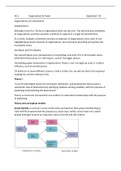HC 1 Organization & Power September 7th
Organizations are everywhere
Organizations:
Although most of us “know an organization when we see one,” the diversity and complexity
of organizations and their activities is difficult to capture in a single formal definition.
As a result, multiple, sometimes contrary conceptions of organizations exist, each of one
highlighting particular features of organizations, but necessarily providing only partial and
incomplete views.
Joel Baum and Tim Rowley.
Ask yourself about your interpretation of something, how does it fit in the broader sense,
what kind of discourses is it referring to. Look at the bigger picture.
Unravelling power dimensions in organizations. Power is not a straight up issue. It is about
influence, control and discourses.
OS builds on so many different sciences. Field is rather rich, we will see that in the required
reading lists and the reference lists.
Theory =
“a set of interrelated constructs (concepts), definitions, and propositions that present a
systematic view of phenomena by specifying relations among variables, with the purpose of
explaining and predicting the phenomena”
Theory is constructs connected to one another to understand relationships with the purpose
of explaining.
Theory and conceptual models
Social identity is a person's sense of who they are based on their group membership(s).
Tajfel (1979) proposed that the groups (e.g. social class, family, soccer team etc.) which
people belonged to were an important source of pride and self-esteem.
,This is a common way to look at theories.
Another way to look at it:
“How can we understand the VU, what it is?”
You can use theory. You can also use the life world perspective. Instead of using
questionnaires, you can also participate in activities that are part and partials of the VU.
What is theory? – 2
Grounded theory is a complex iterative process:
The research begins with the raising of generative questions which help to guide the
research but are not intended to be either static or confining. As the researcher begins to
gather data, core theoretical concept(s) are identified. Tentative linkages are developed
between the theoretical concepts and data.
(Glaser and Strauss are known for Grounded theory)
In this perspective a theory is not a set of fixed variables and hypothesis but rather a way of
looking at the world → A paradigm, heuristic or window
The different perspectives talk to each other differently.
O&P as a social sciences discipline
• The focus is not so much on efficiency and effectiveness (or mngmt tools) but on
understanding (‘verstehen’).
- Different social scientific themes, methods and theories are useful.
- Embedding in social phenomena and developments is crucial
• Common sense, various definitions, biases.
ORGANIZATIONS – I
“Organizations are social entities that are goal-oriented; are designed as deliberately
structured and coordinated activity systems, and are linked to the external environment”
(Daft, 2004)
Organization is “a system of consciously coordinated personal activities or forces” (Chester
Barnard)
ORGANIZATIONS - II
Organizations are arenas of power where discursive struggles take place (Maguire & Hardy,
2006)
,Or authors deny the existence of ‘organizations’ and prefer to talk of processes of
‘organizing’(Tsoukas & Chia, 2002)
Tsoukas and Chia started thinking about the idea of ‘organizing’, rather than talking about
organizations as static objects. They took more of an interest in the organization as a noun.
Makes the field way more dynamic. Gives us an idea of process analysis and change.
Basically brings time perspective in organizations.
Organizations: a view
The view we adopt in this course comes close to Baum and Rowleys (2002: 2)
“Most words ending in “-tion” are ambiguous between process and product – between the
way one gets there, and the result. Our word, organization, shares this ambivalence, itself
referring to the process of “organizing,” or, to the result of organizing.
Although the range of definitions can create confusion, together, they also provide a means
of capturing the full breadth of organizational life.”
So: There is not one way of looking at it. In this course we will analyse organizations, while
having a special interest in power dimensions. We will be talking about conflict, agenda
setting, change, methodology, etc.
, Why bother?
... organizations are all around
... we spend most of our lives, both working and private, in organizations
... large organizations have become dominant in our society
... organizations are able to help solving pressing problems
...organization theory can introduce new perspectives to practice (cf. master thesis):
organizing instead of organizations
According to Bartunek et al (2006), high quality research, next to quality rigor and validity:
- Are interesting
- Produce a higher degree of learning
- Might lead to more graduate students
the first criterion by which people judge anything they encounter, even before deciding
whether it is true or false, is whether it is interesting or boring” (Murray Davis, 1999: 245).
Research needs to be: Counterintuitive / Quality / Good writing / New theory or finding /
practical implications, impact
Why bother with power?
… power dynamics are omnipresent in organizations
… every social interaction is imbued with power – wer are constantly subjected to it
--- power can take different forms and has implications for individuals, organizations and society
more largely (micro, meso, macro level)
… some forms of power are more overt than others
… power is not per se negative or harmful, but it’s good to be aware of it.
There is always a power dynamic or power in an organization or in actual real life situations.
This course sensitizes one to see power. Organizing means looking at the big picture.





